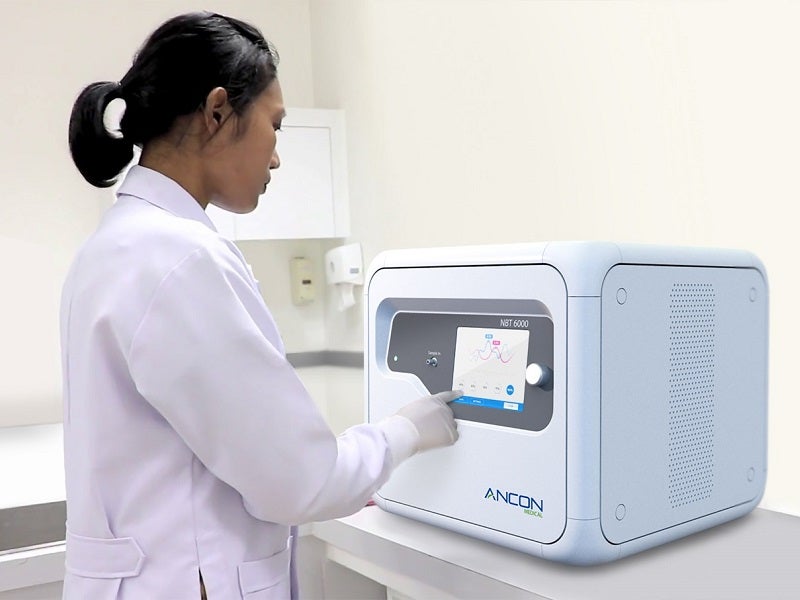
Ancon’s Nanoparticle Biomarker Tagging (NBT) technology works by identifying biomarkers in a patients’ breath. Cancerous tumours – and other illnesses – produce a chemical signature known as a volatile organic compound (VOC), which would not otherwise be found in the human body and can be used to diagnose disease.
By identifying the presence of these VOCs with biomarker tagging, it’s possible to reliably screen and diagnose illnesses like mouth cancer at far earlier stages than existing methods of clinical diagnosis like X-rays, CT scans and MRIs.
Detecting key biomarkers isn’t all that straightforward. Nitrogen, oxygen, carbon dioxide and other molecules can make it very difficult to detect biomarkers on the breath, as they occur in comparatively minute quantities.
Ancon Medical CEO Wesley Baker says: “The sensitivity of the device means that we can detect far lower concentrations of the VOCs in question, which speeds up how long each sample must be taken for. We need just one minute’s worth of breath.
“Then the data is analysed by artificial intelligence once the VOCs present are identified; this AI and machine learning combination means that thousands of pieces of data can be analysed incredibly quickly and with increasing accuracy as more and more data is processed.”
Cutting out misdiagnosis
Unlike other breath testing technology, such as gas chromatography mass spectrometry (GCMA), NBT is easily portable. It consists of a desktop enclosure that examines biomarkers on a molecular level, by physically amplifying the biomarker molecule so it can be easily detected with a laser counter.
How well do you really know your competitors?
Access the most comprehensive Company Profiles on the market, powered by GlobalData. Save hours of research. Gain competitive edge.

Thank you!
Your download email will arrive shortly
Not ready to buy yet? Download a free sample
We are confident about the unique quality of our Company Profiles. However, we want you to make the most beneficial decision for your business, so we offer a free sample that you can download by submitting the below form
By GlobalDataAncon maintains the device can amplify a biomarker from a disposal breath component by nearly one billion times its mass, allowing for single ions and molecules that are indicative of disease to be detected and identified.
“By detecting novel chemicals from breath there is no need to rely on inaccurate methods of diagnosis which give ambiguous results,” says Baker. “For instance, X-rays can show darker or lighter areas that may indicate cancer but often just come from harmless sources. These indicators are of course normally pursued further and can lead to biopsies and a huge amount of anxiety. The ability to take a simple breath screening test will enable patients to have results fast and no unnecessary explorational procedures.”
False positives occur around 10% of the time in oral cancer screening, depending on the specific method and type of cancer, an issue which is also highly prevalent in lung cancer.
“Lung cancer is notoriously bad for false positives,” says Baker. “CT Scans have a 36% rate of false-positive diagnosis and X-rays cannot detect it at an early enough stage to maximise the survivability of the disease.”
By detecting novel chemicals from breath, NBT may enable clinicians to stop relying on less accurate methods of diagnosis which give ambiguous results.
Superior magnification technology
Ancon claims that its NBT system far exceeds the performance of similar ion-magnifying technologies like the Faraday cup where the detection concentration is 10,000 ions per second, or Wilson chamber technology, which is widely used in nuclear physics and can require up to 100,000 ions to produce a detectable signal.
The company has received funding from the Technology Strategy Board UK and the South East England Development Agency (SEEDA). It is on the verge of starting pre-clinical trials into NBT in the US and UK, after earlier successes in human and laboratory testing.
Baker says: “We are all really excited to get started with the process and hope that due to its non-invasive nature we could see the device used sooner rather than later. Our aim is for full clinical trials to start by the end of 2020.
“We are hoping to have the technology to market in several years depending on the trials and regulatory approval in each country.”




